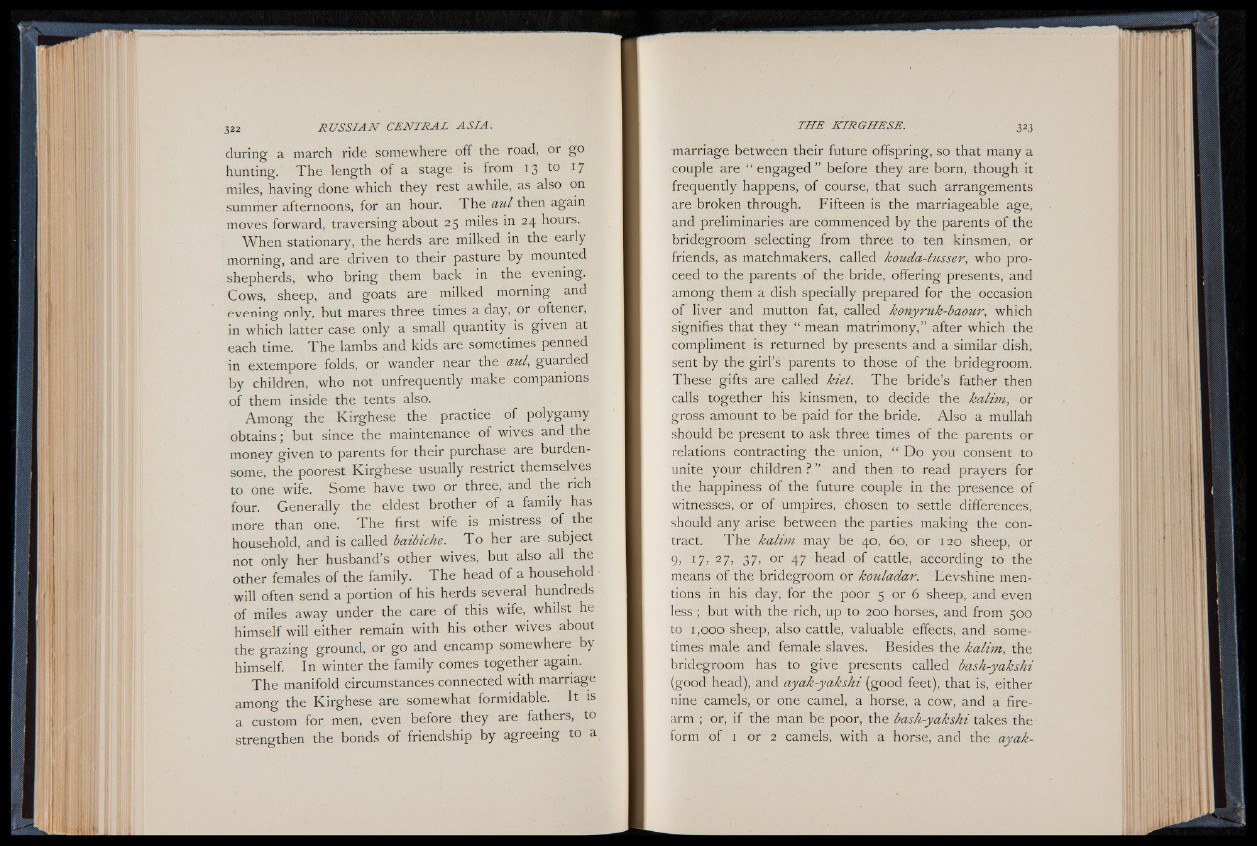
during a march ride somewhere off the road, or go
hunting. The length of a stage is from 13 to 17
miles, having: done which they rest awhile, as also on
. j 1 •
summer afternoons, for an hour. The aul then again
moves forward, traversing about 25 miles in 24 hours.
When stationary, the herds are milked in the early
morning, and are driven to their pasture by mounted
shepherds, who bring them back in the evening.
Cows, sheep, and goats are milked morning and
evening only, but mares three times a day, or oftener,
in which latter case only a small quantity is given at
each time. The lambs and kids are sometimes penned
in extempore folds, or wander near the aul, guarded
by children, who not unfrequently make companions
of them inside the tents also.
Among the Kirghese the practice of polygamy
obtains; but since the maintenance of wives and the
money given to parents for their purchase are burdensome,
the poorest Kirghese usually restrict themselves
to one wife. Some have two or three, and the rich
four. Generally the eldest brother of a family has
more than one. The first wife is mistress of the
household, and is called baibiche. T o her are subject
not only her husband’s other wives, but also all the
other females of the family. The head of a household
will often send a portion of his herds several hundreds
of miles away under the care of this wife, whilst he
himself will either remain with his other wives about
the grazing ground, or go and encamp somewhere by
himself. In winter the family comes together again.
The manifold circumstances connected with marriage
among the Kirghese are somewhat formidable. It is
a custom for men, even before they are fathers, to
strengthen the bonds of friendship by agreeing to a
marriage between their future offspring, so that many a
couple are “ engaged ” before they are born, though it
frequently happens, of course, that such arrangements
are broken through. Fifteen is the marriageable age,
and preliminaries are commenced by the parents of the
bridegroom selecting from three to ten kinsmen, or
friends, as matchmakers, called kouda-tusser, who proceed
to the parents of the bride, offering presents, and
among them a dish specially prepared for the occasion
of liver and mutton fat, called konyruk-baour, which
signifies that they “ mean matrimony,” after which the
compliment is returned by presents and a similar dish,
sent by the girl’s parents to those of the bridegroom.
These gifts are called kiet. The bride’s father then
calls together his kinsmen, to decide the kalim, or
gross amount to be paid for the bride. Also a mullah
should be present to ask three times of the parents or
relations contracting the union, “ Do you consent to
unite your children ? ” and then to read prayers for
the happiness of the future couple in the presence of
witnesses, or of umpires, chosen to settle differences,
should any arise between the parties making the contract.
The kalim may be 40, 60, or 120 sheep, or
9, 17, 27, 37, or 47 head of cattle, according to the
means of the bridegroom or kouladar. Levshine mentions
in his day, for the poor 5 or 6 sheep, and even
less; but with the rich, up to 200 horses, and from 500
to 1,000 sheep, also cattle, valuable effects, and sometimes
male and female slaves. Besides the kalim, the
bridegroom has to give presents called bash-yakshi
(good head), and ayak-yakshi (good feet), that is, either
nine camels, or one camel, a horse, a cow, and a firearm
; or, if the man be poor, the bash-yakshi takes the
form of 1 or 2 camels, with a horse, and the ayak